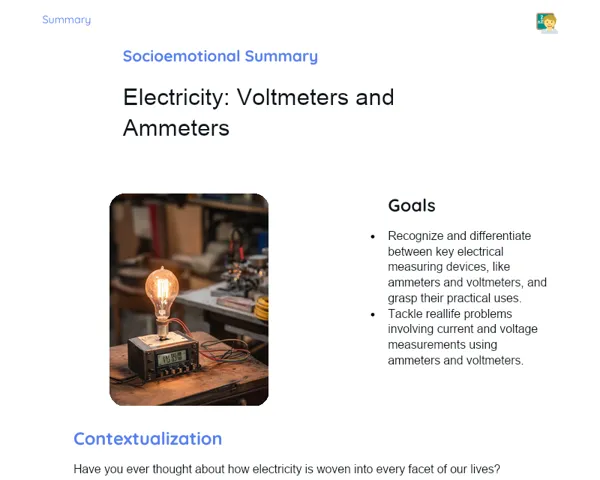Summary Tradisional | Waves: Polarization
Contextualization
Light, which is a type of electromagnetic wave, can vibrate in different directions that are perpendicular to its path of travel. When this typically unpolarized light interacts with certain materials, it can be filtered to vibrate predominantly in a single direction. This process is termed polarization. Polarization is an important phenomenon with various practical uses in our everyday lives—from sunglasses to the screens of our gadgets and even in photography.
For example, sunlight is a form of unpolarized light, meaning its waves vibrate in all directions perpendicular to its path. When it passes through a polarizer, only the components vibrating in a specified direction are allowed to pass, resulting in polarized light. This concept is crucial for many modern technologies and is detailed by Malus's Law, which explains the intensity of light transmitted through a polarizer as related to the angle between the polarization direction of the incoming light and that of the polarizer.
To Remember!
Definition of Light Polarization
Light polarization is all about the orientation of the electric field oscillations of electromagnetic waves. When we say light is unpolarized, it means that its waves are vibrating in multiple directions that are perpendicular to the direction it's moving in. Natural light, like sunlight, is a prime example of unpolarized light.
When this light passes through a polarizer, it allows only those waves vibrating in a selected direction to pass through, blocking out others. What we get is polarized light, where the oscillations are aligned in one direction. You can easily demonstrate this with polarizing filters, which are commonly used in physics lab experiments to illustrate polarization.
The significance of light polarization can be seen in its numerous practical applications spanning various science and tech fields. From cutting glare in sunglasses to enhancing image quality on our electronic device displays, polarization is a vital aspect of our daily routines.
-
Natural light is unpolarized, with oscillations in various directions.
-
A polarizer filters light, passing only one direction of oscillation.
-
Polarization has wide-ranging applications, such as in sunglasses and electronic screens.
Types of Polarization
Polarization comes in three main types: linear, circular, and elliptical. In linear polarization, light waves vibrate in just one direction. A common example of this is the linear polarizing filters we see in sunglasses, designed to reduce glare.
Circular polarization happens when light waves vibrate in two perpendicular directions, but with a phase difference of 90 degrees, leading to circular motion of the electric field. This type of polarization is used in various communication technologies, taking advantage of polarized light's properties for efficient information transmission.
Elliptical polarization is a broader version of circular polarization. In this case, light waves vibrate in two perpendicular directions, but the phase difference is not limited to 90 degrees, resulting in an elliptical motion. While it’s less common, you might encounter this type of polarization in certain laser applications and advanced optical setups.
-
Linear polarization: waves vibrate in a single direction.
-
Circular polarization: waves vibrate in two perpendicular directions with a 90-degree phase difference.
-
Elliptical polarization: waves vibrate in two perpendicular directions where the phase difference is not 90 degrees.
Polarizers and Analyzers
Polarizers are instruments that filter light, permitting only oscillations in a specific direction to come through. They come in various types, such as linear light polarizers, often made with Polaroid filters, and circular light polarizers. These devices are essential for numerous experiments and practical applications involving light polarization.
Analyzers, on the other hand, are used to gauge the polarization of light. They function similarly to polarizers but are utilized to analyze light that has already been polarized. By rotating an analyzer, one can determine the polarization direction of incoming light and measure its intensity.
Polarizers and analyzers play a key role in several scientific and technological areas. For instance, in physics labs, they help demonstrate and study the process of light polarization. Practically, in polarized sunglasses, they help reduce glare and enhance visibility.
-
Polarizers filter light, permitting only one direction of oscillation.
-
We have both linear and circular light polarizers.
-
Analyzers help measure the polarization of light.
Malus's Law
Malus's Law explains how the intensity of light transmitted through a polarizer is influenced by the angle between the polarization direction of the polarizer and that of the incoming light. The formula for Malus's Law is I = I0 * cos²(θ), where I represents the transmitted light intensity, I0 is the intensity of the incoming light, and θ is the angle between the polarization directions.
This law is critical for grasping how the intensity of light changes as it passes through a polarizer. When the polarization direction of the incoming light lines up with that of the polarizer, the transmitted light intensity is at its peak. As the angle θ increases, the intensity drops off, turning to zero once the polarization directions are perpendicular.
Malus's Law has many practical applications, especially in experiments and technologies revolving around light polarization. For example, while using polarized sunglasses, Malus's Law elucidates how the intensity of transmitted light varies with the angle sunlight hits the glasses.
-
Malus's Law explains the intensity of light transmitted through a polarizer.
-
The formula is I = I0 * cos²(θ), where I is the intensity transmitted.
-
Intensity peaks when polarization directions align and hits minimum when they’re perpendicular.
Key Terms
-
Light polarization: The orientation of electric field oscillations in electromagnetic waves.
-
Unpolarized light: Light where waves vibrate in multiple perpendicular directions.
-
Polarizers: Instruments that filter light to allow oscillations in a specific direction.
-
Analyzers: Instruments used to assess the polarization of light.
-
Malus's Law: Explains the light intensity transmitted by a polarizer in relation to the angle between polarization directions.
Important Conclusions
Throughout this lesson, we delved into light polarization, an essential property of electromagnetic waves that describes how the electric field oscillations are oriented. We discovered that natural light is typically unpolarized, with oscillations in various directions, and that passing it through polarizers gives rise to oscillations that align in one specific direction. This understanding is key for various applications in everyday life, including sunglasses, electronic screens, and photography.
Additionally, we explored the different types of polarization—linear, circular, and elliptical—each with unique behaviors and uses. Malus's Law was introduced, serving as a vital tool for comprehending how the intensity of light changes when passing through a polarizer, depending on the angle between the directions of the incident light and the polarizer. This enabled us to tackle real-world problems and gain a better understanding of polarization’s impact on light intensity.
The significance of this topic reaches numerous fields in science and technology, demonstrating how light polarization can greatly enhance our lives, especially when applied in modern technologies. We encourage all students to further investigate this fascinating phenomenon and contemplate its future implications in studies and technological advancements.
Study Tips
-
Review the concepts of light polarization and Malus's Law, tackling problems that require you to calculate light intensity through polarizers.
-
Experiment with polarizing filters at home, noticing their effects on light reflected from different surfaces, and consider practical applications such as wearing polarized sunglasses.
-
Dive deeper into how polarization is used in contemporary technologies like screens on electronic devices and optical communication to appreciate the utility of this phenomenon.


